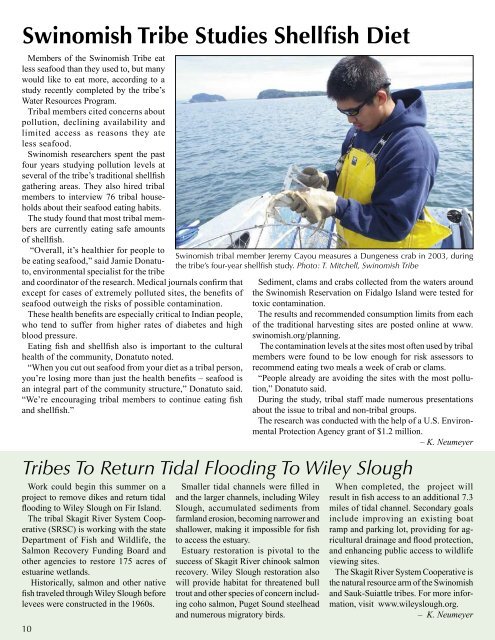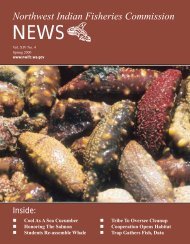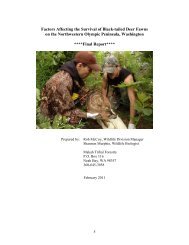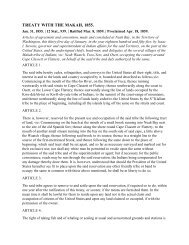NWIFC News - NWIFC Access - Northwest Indian Fisheries ...
NWIFC News - NWIFC Access - Northwest Indian Fisheries ...
NWIFC News - NWIFC Access - Northwest Indian Fisheries ...
You also want an ePaper? Increase the reach of your titles
YUMPU automatically turns print PDFs into web optimized ePapers that Google loves.
Swinomish Tribe Studies Shellfish Diet<br />
Members of the Swinomish Tribe eat<br />
less seafood than they used to, but many<br />
would like to eat more, according to a<br />
study recently completed by the tribe’s<br />
Water Resources Program.<br />
Tribal members cited concerns about<br />
pollution, declining availability and<br />
limited access as reasons they ate<br />
less seafood.<br />
Swinomish researchers spent the past<br />
four years studying pollution levels at<br />
several of the tribe’s traditional shellfish<br />
gathering areas. They also hired tribal<br />
members to interview 76 tribal households<br />
about their seafood eating habits.<br />
The study found that most tribal members<br />
are currently eating safe amounts<br />
of shellfish.<br />
“Overall, it’s healthier for people to<br />
be eating seafood,” said Jamie Donatuto,<br />
environmental specialist for the tribe<br />
and coordinator of the research. Medical journals confirm that<br />
except for cases of extremely polluted sites, the benefits of<br />
seafood outweigh the risks of possible contamination.<br />
These health benefits are especially critical to <strong>Indian</strong> people,<br />
who tend to suffer from higher rates of diabetes and high<br />
blood pressure.<br />
Eating fish and shellfish also is important to the cultural<br />
health of the community, Donatuto noted.<br />
“When you cut out seafood from your diet as a tribal person,<br />
you’re losing more than just the health benefits – seafood is<br />
an integral part of the community structure,” Donatuto said.<br />
“We’re encouraging tribal members to continue eating fish<br />
and shellfish.”<br />
Work could begin this summer on a<br />
project to remove dikes and return tidal<br />
flooding to Wiley Slough on Fir Island.<br />
The tribal Skagit River System Cooperative<br />
(SRSC) is working with the state<br />
Department of Fish and Wildlife, the<br />
Salmon Recovery Funding Board and<br />
other agencies to restore 175 acres of<br />
estuarine wetlands.<br />
Historically, salmon and other native<br />
fish traveled through Wiley Slough before<br />
levees were constructed in the 1960s.<br />
Swinomish tribal member Jeremy Cayou measures a Dungeness crab in 2003, during<br />
the tribe’s four-year shellfish study. Photo: T. Mitchell, Swinomish Tribe<br />
Smaller tidal channels were filled in<br />
and the larger channels, including Wiley<br />
Slough, accumulated sediments from<br />
farmland erosion, becoming narrower and<br />
shallower, making it impossible for fish<br />
to access the estuary.<br />
Estuary restoration is pivotal to the<br />
success of Skagit River chinook salmon<br />
recovery. Wiley Slough restoration also<br />
will provide habitat for threatened bull<br />
trout and other species of concern including<br />
coho salmon, Puget Sound steelhead<br />
and numerous migratory birds.<br />
Sediment, clams and crabs collected from the waters around<br />
the Swinomish Reservation on Fidalgo Island were tested for<br />
toxic contamination.<br />
The results and recommended consumption limits from each<br />
of the traditional harvesting sites are posted online at www.<br />
swinomish.org/planning.<br />
The contamination levels at the sites most often used by tribal<br />
members were found to be low enough for risk assessors to<br />
recommend eating two meals a week of crab or clams.<br />
“People already are avoiding the sites with the most pollution,”<br />
Donatuto said.<br />
During the study, tribal staff made numerous presentations<br />
about the issue to tribal and non-tribal groups.<br />
The research was conducted with the help of a U.S. Environmental<br />
Protection Agency grant of $1.2 million.<br />
– K. Neumeyer<br />
Tribes To Return Tidal Flooding To Wiley Slough<br />
10<br />
When completed, the project will<br />
result in fish access to an additional 7.3<br />
miles of tidal channel. Secondary goals<br />
include improving an existing boat<br />
ramp and parking lot, providing for agricultural<br />
drainage and flood protection,<br />
and enhancing public access to wildlife<br />
viewing sites.<br />
The Skagit River System Cooperative is<br />
the natural resource arm of the Swinomish<br />
and Sauk-Suiattle tribes. For more information,<br />
visit www.wileyslough.org.<br />
– K. Neumeyer









